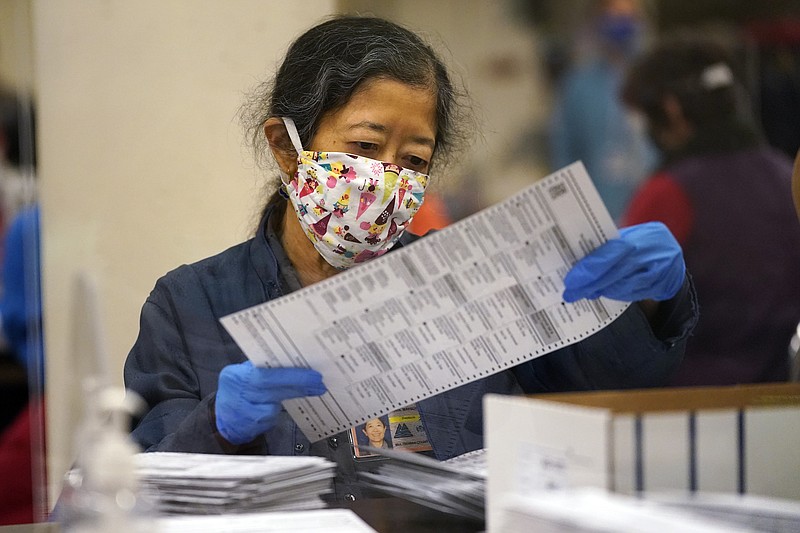More than 150,000 ballots were still caught in Postal Service processing facilities Wednesday, agency data shows, including more than 12,000 in five of the states that have yet to be called for either President Donald Trump or former Vice President Joe Biden.
Another 39,000 ballots were processed Thursday, agency data shows, including more than 4,000 in the remaining swing states of Arizona, Georgia, Nevada, North Carolina and Pennsylvania.
Despite assurances from Postal Service leaders that agency officials were conducting daily sweeps for misplaced ballots, the mail service acknowledged in court filings that thousands of ballots had not been processed in time, and that more ballots were processed Wednesday than on Election Day.
The number of mailed ballots not delivered by Election Day is expected to grow as more postal data is released in the coming days. Some election experts worry such delays could run up against even more generous ballot acceptance windows that some states have granted.
In several swing states, late ballots will still be counted as long as they were postmarked by Election Day and were received by Friday. They include Nevada, where 4,518 ballots arrived Wednesday and 635 arrived Thursday, as well as North Carolina (2,958 on Wednesday and 835 on Thursday) and Pennsylvania (3,439 Wednesday and 1,459 Thursday). But states such as Arizona (864 Wednesday and 559 Thursday) and Georgia (853 Wednesday and 610 Thursday) don't accept any ballots after Election Day.
Sam Spital, litigation director for the NAACP Legal Defense Fund, said the vast majority of ballots in question were delivered in a timely manner and most were in states with lenient ballot acceptance deadlines.
Because the counts are ongoing in those states, it is unclear whether undelivered ballots would have made a difference in deciding the presidential election. But the delivery failures highlight the risks in relying on the mail service to deliver ballots close to Election Day.
The Postal Service had warned voters not to mail ballots within one week of Tuesday's election, even though they are treated as first-class mail, which has a one- to three-day delivery window.
The Biden campaign changed its messaging to encourage voters to use drop boxes or vote in person and avoid the mail system within 10 days of the election.
On Wednesday, the Postal Service processed 94.5% of ballots on time, an improvement over recent days but below the 97% rate that postal and voting experts expect. Based on the agency's one- to three-day ballot processing window, voters would have mailed those ballots on Sunday or Monday.
For the remaining 5.5%, or more than 8,000, of ballots that took longer to process, they would have been mailed between Thursday and today.
In the nine postal districts serving the swing states of Arizona, Nevada, Pennsylvania, North Carolina and Georgia -- which have yet to decide the presidential race -- the on-time rate was 84.6%. That means roughly 15 out of every 100 ballots in processing plants were not sorted -- or delivered -- in time.
Postal Service spokesman David Partenheimer wrote in an emailed statement that the majority of the 150,000 ballots processed Wednesday were destined for states that accept ballots with pre-Election Day postmarks and that the votes would be counted under state laws.
"The Postal Service is required by law to deliver all mail that is deposited in our system. We cannot control when voters choose to mail their completed ballots, but we implemented extraordinary measures to ensure ballots were, and continue to be, delivered to the boards of elections as quickly as possible," he wrote.
On Election Day, postal workers were instructed to submit ballots directly to vote counters, bypassing the regional facilities that account for the processing scores submitted Thursday to Judge Emmet Sullivan in U.S. District Court for the District of Columbia. Sullivan is overseeing one of several voting rights lawsuits filed in the aftermath of the Postal Service's well-documented service declines. But the delivery numbers alarmed civil rights advocates, who say the Postal Service was a vital and unavoidable component of election infrastructure for millions of Americans in the midst of the coronavirus pandemic.
Justice Department lawyers representing the mail agency have cautioned that the figures are not reliable. The data does not include "first mile" and "last mile" handling steps, which could add time to delivery, and only accounts for items the agency was able to successfully identify as ballots.
The Postal Service also aggregates bar code tracking scans for a ballot's point of origin and destination into one report, meaning ballots that travel within the same postal district are counted twice. In analyzing the data, The Washington Post counted every ballot once, since the vast majority of ballots are sent locally.
Some postal districts straddle state lines, but the Postal Service data does not specify how ballots in these districts are distributed between states. The Post's state-level calculations assign a state every ballot of every district overlapping with that state. The numbers should be considered theoretical maximum values rather than precise tallies.
For example, the three postal districts encompassing Georgia also cover parts of Tennessee, South Carolina and Florida. It is highly unlikely that all the reported missing ballots are from Georgia voters.
The Postal Service reported to Congress on Thursday that it had processed 135 million ballots since Sept. 4, including blank ballots from election officials to voters, and completed ballots being returned to vote counters.
